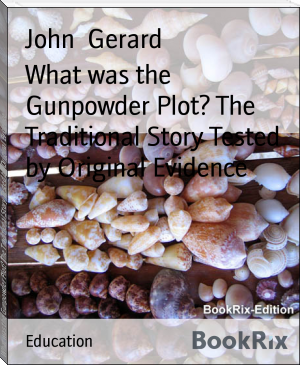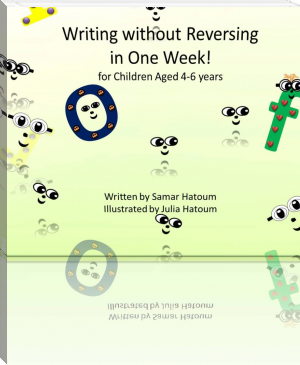What was the Gunpowder Plot? The Traditional Story Tested by Original Evidence by John Gerard (top 10 most read books in the world .TXT) 📕

- Author: John Gerard
Book online «What was the Gunpowder Plot? The Traditional Story Tested by Original Evidence by John Gerard (top 10 most read books in the world .TXT) 📕». Author John Gerard
HAVING followed the history of the plotters and their doings, to the point when everything was ready for action, we have now to inquire what, in the meantime, those were about for whose destruction such notable preparations were making, and whether in truth they were, as we are assured, wrapped in a sense of false security, and altogether unconscious of the signs and tokens that should have awakened their suspicion and alarm.
When, by the aid of such evidence as remains to us, we turn to examine the facts of the case, we discover in them, it must be confessed, no symptoms whatever of supineness or lethargy. It appears, on the contrary, that throughout the period when the government are supposed to have been living in a fool's paradise, and tranquilly assuming that all was well, they were in reality busily at work through their emissaries and informers, prying into all the doings of the recusant Catholics, receiving frequent intimation of all that was undertaken, or even projected, and, apparently, regulating the main features of a treasonable conspiracy, which can have been no other than the Powder Plot itself, determining, in particular, what individuals should be implicated therein.
In April, 1604, at the very time when we hear of the Plot as being hatched, a letter was addressed to Sir Thomas Challoner, an official frequently mixed up with business of this kind, by one Henry Wright,[200] reporting the proceedings of a subordinate agent, by name Davies, whom he styles a "discoverer,"[201] then engaged in working a Catholic treason, with the special object of incriminating priests. Davies has offered to "set," or mark down,[202] over threescore of these, but Wright has told him that so many are not required, and that he will satisfy his employers if he implicate twenty, provided they be "most principal Jesuits and seminary priests," and therewithal has given him thirteen or fourteen names that will serve the required purpose. Davies replies, "that by God's grace he will absolutely do it ere long."[203]
That the treason in question was none other than the Gunpowder Plot there can be no question, unless indeed we are to say that the authorities were engaged in fabricating a bogus conspiracy for which there was no foundation whatever in fact. It was not the way of statesmen of the period, when on the track of sedition, to relinquish the pursuit till they had sifted it to the bottom, and at this juncture, especially, every shred of evidence regarding Catholics and their conduct was threshed out to the uttermost. In consequence, we are able to say with certainty, that besides the enterprise of Catesby and his associates, there was no other conspiracy of any kind on foot. We have, moreover, already seen that the very same point thus by anticipation represented as all important, is that which after the "discovery" every nerve was strained to establish, namely, the complicity of the Catholic clergy. If we had no more than this internal evidence, it would abundantly suffice to assure us that the conspiracy thus sedulously watched was the same as that miraculously "discovered" a year and a half later.
But we are not left to such inferences alone. In March, 1606, we find Wright applying to the minister for a reward on account of his services "in discovering villainous practices," thus indicating that by this time those which he had been tracking had been brought to light. More explicit still is a memorial presented to the king, at a later date, on his behalf. This is entitled--"Touching Wright and his services performed in the damnable plot of the Powder treason." King James is reminded that Chief Justice Popham and Sir Thomas Challoner had a hand in the discovery of the Powder, and this by means of information supplied by Wright, "for two years space almost" before his Majesty interpreted the famous letter to Lord Monteagle, "like an angel of God." This information Popham and Challoner had from time to time communicated to his Majesty, "whose hand Wright hath in testimony of his services in the matter."[204]
In the same month of April, 1604, was supplied another piece of information, singularly interesting and important,[205] in which were detailed the particulars of a design amongst the Catholics at home and abroad. Much, in fact the bulk, of the information given, is seen, in the light of our present knowledge, to be purely fictitious, affording a good example of the "sophistications" which, as Cecil himself complained, his agents were wont to mingle with their intelligence. The design in question was represented as being of the most serious and secret nature, the papists thinking that it "must now be so handled and carried as the great cause may lose no reputation, or if any suspicion should grow in the state, or any come in question therefore, the main point might never come to light;" the said "main point" being of course the complicity of the Catholic clergy.
What invests this document with singular importance is the fact that we hear of it again. In April, 1606, it was quoted for the benefit of Parliament by the Attorney General, Sir E. Coke, and explicitly as having reference to the Gunpowder Plot, forming part of the evidence adduced by him to secure the attainder of persons accused of being partakers in that treason.[206] It thus affords a proof, on the authority of the government itself, that eighteen months before the conspiracy was "discovered," intelligence regarding it had been received and was being attended to.
This is, however, by no means the only information of which we find traces. Amongst the Cecil papers at Hatfield is a letter dated December 20th, 1605, addressed to the Earl of Salisbury by one Thomas Coe, who claims to have previously forwarded to his Majesty "the primary intelligence of these late dangerous treasons," upon which communication the historian Lodge observes,[207] "It should seem then that the famous letter transmitted to James by Lord Monteagle, for the right construction of which that Prince's penetration hath been so highly extolled by some historians, was not the only previous intelligence communicated to him of the Gunpowder Treason."
Meanwhile the officers of the government, in all parts, appear to have been no less alert than was their wont. On the 9th of January, 1604-5, for instance, Sir Thomas Parry writes from Paris,[208] inclosing a note from an informer at Dieppe, concerning an English Catholic returning from Italy and Spain with letters for Fathers Garnet and Oldcorne, and a cipher of three lines for a lawyer at Douay, and although the messenger has contrived to give him the slip, he is able to send particulars concerning his personal appearance, and the locality in London where he is likely to be found. On the 25th of the same month, Cecil replies to Parry[209] concerning priests and their doings, and makes the valuable admission that their proceedings are always known to him by means of false brethren, though, he adds, these informers always add to their intelligence "sophistications" of their own, a fact which must not be lost sight of in studying the reports of such folk. We hear particularly of informations supplied by the priests Bagshawe and Cecil, by Captain Turner, Charles Paget, and sundry others.
At the beginning of October, 1605, we make the acquaintance of another notable informer. On the first of the month, William Willaston, then engaged on a commission in France in connection with a proposed commercial treaty, writes to Cecil from Paris[210] concerning a Catholic design attributed chiefly to priests and Jesuits, who have assurance that their friends in England, who are many and of good sort, intend "to kindle a fire in many corners of our land, and a rebellion in Ireland," and that these matters be almost grown to a head, "some of their fingers itching to be set to work." Willaston adds, "there is a particular irreconcilable desperate malice against your Honour's person, which is principally the cause I make bold to write unto your Lordship. You have yet the papists in your hands, and are masters; if you let them increase and grow so insolent, assuredly it will come to pass as to the King of Israel, who having overthrown Benhadab ..." and so on.
On October 14th, Willaston again writes from Rouen[211] "about some matters pretended by our Romish Catholics." The party, he says, "who" has given light into this business "is one George Southwaick, well-known to many of your Lordship's followers." This Southwaick, he holds to be "very honest;" he is going to England with sundry priests and others, and upon landing will at once communicate with the authorities and have his comrades arrested. "Southwaick himself," adds Willaston, "must be taken as well as the others, for he desireth not to be known to have given any information against the rest. If it please your Lordship to take order for his imprisonment apart, that conference privately may be had with him, until such time as shall be thought fit to deliver him, he can give you good directions for many matters, and may stand your honour in stead for such purposes."
There follows a notable suggestion: "If your Lordship would be pleased to set some man to win the Nuncio of the Pope his secretary in Paris, you should receive very direct and sound instructions from him." The writer goes on to speak of an intended rebellion in England, and the kindling of a fire there, and dutifully concludes, "God grant they touch not the person of the King nor of his children."
On the 27th of October, nine days before the "discovery," Southwaick himself, now in England, writes to Cecil,[212] urging that the impending arrest of priests and others should be deferred, and that for better management of "the business, and for the better and more substantial manifestation thereof," he ventures to suggest that "more scope of time would make the service of more worth." Moreover, he gives warning of preparations for trouble in the shires, in connection with "their plot," and finally promises, "your Honour shall not only have knowledge of all such as are any way intercepted in the same, but also knowledge of the end of their whole purpose, and withal be certain of their meeting here in London, where I do not doubt to apprehend forty priests, with many great of name, at mass, in good speed of their great intent."
On the morning of the 5th of November itself, evidently before receiving news that the final blow had been struck, Southwaick writes to Levinus Munck, Cecil's private secretary.[213] He excuses himself for recent silence on the ground that he could not without prejudice to "the business" have communicated with his employers. "The parties," he declares, "have had, ever since I saw you, such obscure meetings, such mutable purposes, such uncertain resolutions, as hath made me ride both day and night, as well in foul weather as fair, omitting no opportunities, lest I should not effect what I have by the weight of my credit and the engagement of my duty and reputation propounded to my honourable Lord." He farther begs that nothing may be done that might disclose his true character to his intended victims, and concludes by declaring that, if he be not much mistaken, he is about "a singular service."
If such letters proved nothing more, they would abundantly serve to discredit the idea that a government which conducted its operations in such a fashion could be hoodwinked by such clumsy contrivances as those of the cellar and the mine.
Five days later,[214] Southwaick again writes to Munck, inclosing a note of the priests who have had meetings in Paris, or have been written to in England. The Ambassador (in Paris) will, he says, bear witness that, although unable to particularize, he had given notice two months since that there was a plot brewing. He adds a significant hint, the like of which we have already seen: "Should I chance





Comments (0)